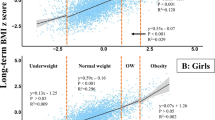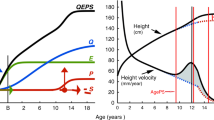Abstract
OBJECTIVE: To investigate the effect of adjusting for differences in timing of maturation when assessing overweight prevalence among adolescents in different populations by using an international reference recommended by the WHO.
DESIGN: Cross-sectional, comparative study in three large samples from China, Russia and the United States.
SUBJECTS: A total of 2014 American, 1316 Chinese and 744 Russian non-pregnant adolescent girls aged 10–18 y.
MEASUREMENTS: Data on body weight, height, menarcheal status and age at menarche (AAM) were collected. Overweight was defined as age-sex-specific body mass index (BMI) greater than the 85th percentiles from the US NHANES I data (collected in 1971–1974), which is recommended by the WHO for international use. Maturity adjustments were made using population differences in median age at menarche (MAM), calculated using the status quo method. MAM was 12.8 in the WHO reference population, 13.7 in China, 13.2 in Russia, and 12.6 in the US (NHANES III data). Maturation age-matched BMI cut-offs were used to compute the adjusted prevalence. We also compared population-adjusted results with individually adjusted results in post-menarcheal American girls (based on each girl's AAM) and in pre-menarcheal girls (based on breast stage).
RESULTS: Maturity adjustment increased the estimated prevalence of overweight in China and Russia where girls mature later than the reference population, and decreased it in the NHANES III sample. The unadjusted and adjusted prevalence was 3.5 vs 4.9% in the China sample, 8.3 vs 9.7% in Russia, and 29.2 vs 28.0% in the US. The adjustment had a greater effect in younger adolescent girls (10–13 y) than in older girls (14–18 y). In general, we found a good agreement between the population and individual adjustments. Viewing the individual adjustment as a ‘gold standard’, the population method has a high sensitivity and specificity.
CONCLUSION: This is the first study to assess WHO recommendations for maturation adjustment when estimating overweight prevalence in different countries. While the overall effects of adjustment are small, maturation status should be considered, particularly when assessing young adolescents, and populations with markedly different timing of maturation relative to the international reference. Population-based adjustment is useful and practical in situations where individual maturity data are not available.
International Journal of Obesity (2001) 25, 550–558
This is a preview of subscription content, access via your institution
Access options
Subscribe to this journal
Receive 12 print issues and online access
$259.00 per year
only $21.58 per issue
Buy this article
- Purchase on Springer Link
- Instant access to full article PDF
Prices may be subject to local taxes which are calculated during checkout

Similar content being viewed by others
References
Bary GA, Bouchard C, James WPT . Handbook of obesity Marcel Dekker: New York 1998 93–102, 819–829.
Power C, Lake JK, Cole TJ . Measurement and long-term health risks of child and adolescent fatness Int J Obes Relat Metab Disord 1997 21: 507–526.
Troiano RP, Flegal KM, Kuczmarski RJ, Campbell SM, Johnson CL . Overweight prevalence and trends for children and adolescents: the National Health and Nutrition Examination Surveys, 1963 to 1991 Arch Pediatr Adolesc Med 1995 149: 1085–1091.
WHO . Obesity: preventing and managing the global epidemic —report of a WHO consultation on obesity WHO: Geneva 1998.
Must A, Dallal GE, Dietz WH . Reference data for obesity: 85th and 95th percentiles of body mass index (wt/ht2) and triceps skinfold thickness Am J Clin Nutr 1991 53: 839–846.
WHO Expert Committee . Physical status, the use and interpretation of anthropometry WHO: Geneva 1995 263–311, 445.
Cole TJ, Bellizzi MC, Flegal KM, Dietz WH . Establishing a standard definition for child overweight and obesity worldwide: international survey Br Med J 2000 320: 1240–1243.
Eveleth PB, Tanner JM . Worldwide variation in human growth Cambridge University Press: New York 1990.
Falkner F, Tanner JM . Human growth: a comprehensive treatise Volume 3: Methodology and ecological, genetic, and nutritional effects on growth. Plenum Press: New York 1986 56–57, 307–313.
Mahan LK, Rees JM . Nutrition in adolescence Times Mirror/Mosby College Press: St Louis 1984 1–15.
Morabia A, Costanza C . International variability in ages at menarche, first live birth, and menopause Am J Epidemiol 1998 148: 1195–1205.
Himes JH . Maturation-related daviations and misclassification of status and weight in adolescence Am J Hum Biol 1999 11: 499–504.
Beunen GP, Malina RM, Lefevre JA, Claessens AL, Renson R, Vanreusel B . Adiposity and biological maturity in girls 6–16 y of age Int J Obes Relat Metab Disord 1994 18: 542–546.
Daniels SR, Khoury PR, Morrison JA . The utility of body mass index as a measure of body fatness in children and adolescents: differences by race and gender Pediatrics 1997 99: 804–807.
Frisch RE, Revelle R . Height and weight at menarche and a hypothesis of critical body weights and adolescent events Science 1970 169: 397–399.
Frisch RE, Revelle R . The height and weight of girls and boys at the time of initiation of the adolescent growth spurt in height and weight and the relationship to menarche Hum Biol 1971 43: 140–159.
Jaruratanasirikul S, Mo-suwan L, Lebel L . Growth pattern and age at menarche of obese girls in a transitional society J Clin Endocrinol Metab 1997 10: 487–490.
Morrison JA, Barton B, Biro FM, Sprecher DL, Falkner F, Obarzanek E . Sexual maturation and obesity in 9- and 10-year-old black and white girls: the National Heart, Lung, and Blood Institute Growth and Health Study J Pediatr 1994 124: 889–895.
Scott EC, Johnston FE . Critical fat, menarche, and the maintenance of menstrual cycles: a critical review J Adolesc Health Care 1982 2: 249–260.
Van Lenthe FJ, Kemper CG, van Mechelen W . Rapid maturation in adolescence results in greater obesity in adulthood: the Amsterdam Growth and Health Study Am J Clin Nutr 1996 64: 18–24.
Kemper HC, Verschuur R, Ritmeester JW . Longitudinal development of growth and fitness in early and late maturing teenagers Pediatrician 1987 14: 219–225.
Garn SM, LaVelle M, Rosenberg KR, Hawthorne VM . Maturational timing as a factor in female fatness and obesity Am J Clin Nutr 1986 43: 879–883.
Garn SM . The secular trend in size and maturational timing and its implications for nutritional assessment J Nutr 1987 117: 817–823.
Garn SM, LaVelle M, Pilkington JJ . Comparisons of fatness in premenarcheal and postmenarcheal girls of the same age J Pediatr 1983 103: 328–331.
Wellens R, Malina RM, Roche AF, Chumlea WC, Guo S, Siervogel RM . Body size and fatness in young adults in relation to age at menarche Am J Hum Biol 1992 4: 783–787.
Guo SS, Chumlea WC, Roche AF, Siervogel RM . Age- and maturity-related changes in body composition during adolescence into adulthood: the Fels longitudinal study Appl Radiat Isot 1998 49: 581–585.
Tanner JM . Menarcheal age Science 1981 214: 604, 606.
Hamill VVV . NCHS growth curves for children, birth–18 y: US. Vital and health statistics, series 11 US Department of Health, Education and Welfare: Hyattsville, MD 1974.
MacMahon B . Age at menarche Vital and health statistics, series 11, no. 133 US Department of Health, Education and Welfare: Hyattsville, MD 1973.
Popkin BM, Keyou G, Zhai F, Guo X, Ma H, Zohoori N . The nutrition transition in China, a cross-sectional analysis Eur J Clin Nutr 1993 47: 333–346.
US DHHS . Plan and operation of the third National Health and Nutrition Examination Survey, 1988–94 Vital and health statistics, no. 32 US Department of Health and Human Services, Public Health Service: Hyattsville, MD, Centers for Disease Control and Prevention, National Center for Health Statistics: Washington, DC 1994.
Lin WS, Chen AC, Su JZ, Zhu FC, Xing WH, Li JY, Ye GS . The menarcheal age of Chinese girls Ann Hum Biol 1992 19: 503–512.
Gao E, Gu J, Tao J . Analysis of menarche age of major minority nationalities in China. In: Guo E, Shah I (eds) Progress of social science research on reproductive health Anthology of treatises of the international symposium on social science research in reproductive health, Shanghai, China, October 1994. China Population Publish House 1997.
Liu GR . An investigation of adolescent health from China J Adolesc Health 1997 20: 306–308.
Godina EZ, Iampol'skaia IuA, Giliarova OA, Zubareva VV . The age of appearance of first menses in women of different regions of Russia Gigiena i Sanitariia 1995 3: 30–32 (in Russian).
Dubrova YE, Kurbatova OL, Kholod ON, Prokhorovskaya VD . Secular growth trend in two generations of the Russian population Hum Biol 1995 67: 755–767.
Bullough VL . Age at menarche: a misunderstanding Science 1981 213: 365–366.
Wyshak G . Secular changes in age at menarche in a sample of US women Ann Hum Biol 1983 10: 75–77.
Wyshak G, Frisch RE . Evidence for a secular trend in age of menarche New Engl J Med 1982 306: 1033–1035.
Herman-Giddens ME, Slora EJ, Wasserman RC, Bourdony CJ, Bhapkar MV, Koch GG, Hasemeier CM . Secondary sexual characteristics and menses in young girls seen in office practice: a study from the Pediatric Research in Office Settings network Pediatrics 1997 99: 505–512.
Stokes ME, Davis CS, Koch CG . Categorical data analysis using the SAS system SAS Institute Inc.: Cary, NC 1995 33–36.
United Nations . Demographic yearbook, 1995 United Nations: New York 1997.
Acknowledgements
The study was supported in part by grants from the National Institutes of Health (P01-HD28076-01 and R01-HD30880), by the Fogarty International Center, NIH, National Science Foundation (grant no. 37486). We thank Dr Barry Popkin, for his important help and support for this study. We also thank Ms Dora Ilyasova for her help on reviewing studies published in Russian, Drs Ties Boerma, June Stevens and Lenore Arab (Kohlmeier) for their help and comments at the early stage of this study, and Ms Frances Dancy for her administrative assistance. We are very grateful to the four anonymous reviewers for their comments and suggestions to improve this paper.
Author information
Authors and Affiliations
Corresponding author
Rights and permissions
About this article
Cite this article
Wang, Y., Adair, L. How does maturity adjustment influence the estimates of overweight prevalence in adolescents from different countries using an international reference?. Int J Obes 25, 550–558 (2001). https://doi.org/10.1038/sj.ijo.0801580
Received:
Revised:
Accepted:
Published:
Issue Date:
DOI: https://doi.org/10.1038/sj.ijo.0801580
Keywords
This article is cited by
-
Associations of pubertal stage and body mass index with cardiometabolic risk in Hong Kong Chinese children: A cross-sectional study
BMC Pediatrics (2015)
-
Age, sex and ethnic differences in the prevalence of underweight and overweight, defined by using the CDC and IOTF cut points in Asian children
European Journal of Clinical Nutrition (2009)
-
Early sexual maturation, central adiposity and subsequent overweight in late adolescence. A four-year follow-up of 1605 adolescent Norwegian boys and girls: the Young HUNT study
BMC Public Health (2007)
-
Early Sexual Maturation, Body Composition, and Obesity in African‐American Girls
Obesity Research (2004)
-
Epidemiology of childhood obesity—methodological aspects and guidelines: what is new?
International Journal of Obesity (2004)



